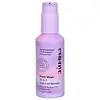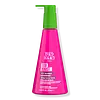What's inside
What's inside
 Benefits
Benefits

 Concerns
Concerns

 Ingredients Side-by-side
Ingredients Side-by-side

Water
Skin ConditioningHydrolyzed Soy Protein
HumectantStearyl Alcohol
EmollientBehentrimonium Methosulfate
Cetearyl Alcohol
EmollientCetyl Alcohol
EmollientArgania Spinosa Kernel Oil
EmollientHydrolyzed Vegetable Protein
Skin ConditioningAdansonia Digitata Seed Oil
EmollientPrunus Amygdalus Dulcis Oil
Skin ConditioningCocos Nucifera Oil
MaskingRicinus Communis Seed Oil
MaskingAloe Barbadensis Leaf Juice
Skin ConditioningPanthenol
Skin ConditioningHydrogenated Castor Oil/Sebacic Acid Copolymer
EmollientPolyquaternium-6
Hydroxypropyl Guar
Emulsion StabilisingGuar Hydroxypropyltrimonium Chloride
Skin ConditioningDimethicone
EmollientBenzoic Acid
MaskingDehydroacetic Acid
PreservativePhenoxyethanol
PreservativeParfum
MaskingWater, Hydrolyzed Soy Protein, Stearyl Alcohol, Behentrimonium Methosulfate, Cetearyl Alcohol, Cetyl Alcohol, Argania Spinosa Kernel Oil, Hydrolyzed Vegetable Protein, Adansonia Digitata Seed Oil, Prunus Amygdalus Dulcis Oil, Cocos Nucifera Oil, Ricinus Communis Seed Oil, Aloe Barbadensis Leaf Juice, Panthenol, Hydrogenated Castor Oil/Sebacic Acid Copolymer, Polyquaternium-6, Hydroxypropyl Guar, Guar Hydroxypropyltrimonium Chloride, Dimethicone, Benzoic Acid, Dehydroacetic Acid, Phenoxyethanol, Parfum
Water
Skin ConditioningGlycerin
HumectantPropylene Glycol
HumectantPolyquaternium-10
Guar Hydroxypropyltrimonium Chloride
Skin ConditioningPvp
Emulsion StabilisingAmodimethicone
Trideceth-12
EmulsifyingCetrimonium Chloride
AntimicrobialPhenoxyethanol
PreservativeMethylparaben
PreservativeEthylparaben
PreservativePropylparaben
PreservativeButylparaben
MaskingHydrolyzed Keratin
HumectantPEG/PPG-20/15 Dimethicone
EmulsifyingPEG-8 Methicone
EmollientCyclomethicone
EmollientPhenyl Trimethicone
Skin ConditioningStearalkonium Chloride
PreservativeCitric Acid
BufferingParfum
MaskingAmyl Cinnamal
PerfumingHydroxycitronellal
PerfumingHydroxyisohexyl 3-Cyclohexene Carboxaldehyde
MaskingButylphenyl Methylpropional
PerfumingLinalool
PerfumingCitronellol
PerfumingHexyl Cinnamal
PerfumingLimonene
PerfumingCI 17200
Cosmetic ColorantWater, Glycerin, Propylene Glycol, Polyquaternium-10, Guar Hydroxypropyltrimonium Chloride, Pvp, Amodimethicone, Trideceth-12, Cetrimonium Chloride, Phenoxyethanol, Methylparaben, Ethylparaben, Propylparaben, Butylparaben, Hydrolyzed Keratin, PEG/PPG-20/15 Dimethicone, PEG-8 Methicone, Cyclomethicone, Phenyl Trimethicone, Stearalkonium Chloride, Citric Acid, Parfum, Amyl Cinnamal, Hydroxycitronellal, Hydroxyisohexyl 3-Cyclohexene Carboxaldehyde, Butylphenyl Methylpropional, Linalool, Citronellol, Hexyl Cinnamal, Limonene, CI 17200
Ingredients Explained
These ingredients are found in both products.
Ingredients higher up in an ingredient list are typically present in a larger amount.
This ingredient is derived from guar gum.
It is a conditioning ingredient, meaning it helps soften skin and hair.
Parfum is a catch-all term for an ingredient or more that is used to give a scent to products.
Also called "fragrance", this ingredient can be a blend of hundreds of chemicals or plant oils. This means every product with "fragrance" or "parfum" in the ingredients list is a different mixture.
For instance, Habanolide is a proprietary trade name for a specific aroma chemical. When used as a fragrance ingredient in cosmetics, most aroma chemicals fall under the broad labeling category of “FRAGRANCE” or “PARFUM” according to EU and US regulations.
The term 'parfum' or 'fragrance' is not regulated in many countries. In many cases, it is up to the brand to define this term.
For instance, many brands choose to label themselves as "fragrance-free" because they are not using synthetic fragrances. However, their products may still contain ingredients such as essential oils that are considered a fragrance by INCI standards.
One example is Calendula flower extract. Calendula is an essential oil that still imparts a scent or 'fragrance'.
Depending on the blend, the ingredients in the mixture can cause allergies and sensitivities on the skin. Some ingredients that are known EU allergens include linalool and citronellol.
Parfum can also be used to mask or cover an unpleasant scent.
The bottom line is: not all fragrances/parfum/ingredients are created equally. If you are worried about fragrances, we recommend taking a closer look at an ingredient. And of course, we always recommend speaking with a professional.
Learn more about ParfumPhenoxyethanol is a preservative that has germicide, antimicrobial, and aromatic properties. Studies show that phenoxyethanol can prevent microbial growth. By itself, it has a scent that is similar to that of a rose.
It's often used in formulations along with Caprylyl Glycol to preserve the shelf life of products.
Water. It's the most common cosmetic ingredient of all. You'll usually see it at the top of ingredient lists, meaning that it makes up the largest part of the product.
So why is it so popular? Water most often acts as a solvent - this means that it helps dissolve other ingredients into the formulation.
You'll also recognize water as that liquid we all need to stay alive. If you see this, drink a glass of water. Stay hydrated!
Learn more about Water